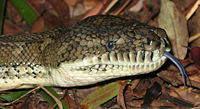
Limb reduction in squamate reptiles correlates with the reduction of the chondrocranium: A case study on serpentiform anguids
Sign Up to like & getrecommendations! Published in 2021 at "Developmental Dynamics"
DOI: 10.1002/dvdy.307
Abstract: In vertebrates, the skull evolves from a complex network of dermal bones and cartilage—the latter forming the pharyngeal apparatus and the chondrocranium. Squamates are particularly important in this regard as they maintain at least part… read more here.
Keywords: reduction; chondrocranium; squamate reptiles; reduction squamate ... See more keywords

The structure of the nasal chemosensory system in squamate reptiles. 2. Lubricatory capacity of the vomeronasal organ
Sign Up to like & getrecommendations! Published in 2018 at "Journal of Biosciences"
DOI: 10.1007/bf03404913
Abstract: The vomeronasal organ is a poorly understood accessory olfactory organ, present in many tetrapods. In mammals, amphibians and lepidosaurian reptiles, it is an encapsulated structure with a central, fluid-filled lumen. The morphology of the lubricatory… read more here.
Keywords: squamate reptiles; system; vomeronasal; vomeronasal organ ... See more keywords

Novel Approaches for Phylogenetic Inference from Morphological Data and Total‐Evidence Dating in Squamate Reptiles (Lizards, Snakes, and Amphisbaenians)
Sign Up to like & getrecommendations! Published in 2017 at "Systematic Biology"
DOI: 10.1093/sysbio/syw068
Abstract: Abstract Here, I combine previously underutilized models and priors to perform more biologically realistic phylogenetic inference from morphological data, with an example from squamate reptiles. When coding morphological characters, it is often possible to denote… read more here.
Keywords: total evidence; phylogenetic inference; squamate reptiles; evidence ... See more keywords

Scaling of erythrocyte shape and nucleus size among squamate reptiles: reanalysis points to constrained, proportional rather than adaptive changes
Sign Up to like & getrecommendations! Published in 2023 at "Royal Society Open Science"
DOI: 10.1098/rsos.221513
Abstract: Small erythrocytes might be beneficial for blood rheology, as they contribute less to blood viscosity than large erythrocytes. We predicted that rheological disadvantages of larger erythrocytes could be alleviated by relatively smaller nucleus size in… read more here.
Keywords: cell; nucleus size; ratio; squamate reptiles ... See more keywords